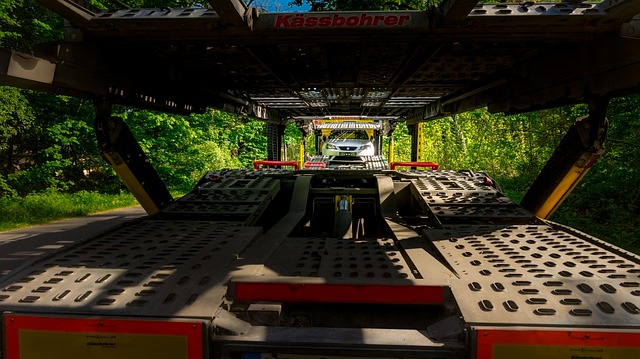Learn how to register your car in California with our comprehensive guide. The process involves understanding key steps, gathering essential documents, and engaging the DMV and a VIN verifier. We break down each stage, from collecting required paperwork to the role of these critical entities like the DMV and VIN verifier. By following these straightforward steps, you’ll be on your way to securing your vehicle’s registration in no time.
- Understanding the California Car Registration Process
- Gathering Necessary Documents for Registration
- The Role of the DMV and VIN Verifier in Car Registration
- Steps to Register a Vehicle in California
- Post-Registration Tasks and Important Considerations
Understanding the California Car Registration Process

Understanding the California Car Registration Process
In California, car registration involves several key steps that ensure vehicles on the road meet safety and environmental standards. It begins with a thorough inspection conducted by a certified professional or the California Department of Motor Vehicles (DMV) using a vin verifier to cross-reference the vehicle’s unique identification number (VIN). This process verifies the car’s authenticity and ensures it complies with emission and safety regulations. After successful inspection, owners can proceed with applying for registration at their local DMV office, providing necessary documents such as proof of insurance, title, and identity.
The California DMV offers both in-person and mobile vin verification services to cater to different needs. Mobile vin verifiers streamline the process by allowing inspections at alternative locations, particularly beneficial for those with busy schedules or limited mobility. This flexibility ensures that registering a vehicle in California is convenient and accessible without compromising on safety and regulatory compliance.
Gathering Necessary Documents for Registration

Before you begin the registration process, it’s crucial to gather all the essential documents required by the California Department of Motor Vehicles (DMV). This includes proof of ownership, typically a vehicle title, along with valid identification like a driver’s license or passport. Additionally, you’ll need your Vehicle Identification Number (VIN) from the car’s chassis or registration label—a quick and easy process often facilitated by a DMV VIN verifier, which can save you time and potential headaches down the line.
For out-of-state transfers, ensure you have a completed Vehicle History Report or a valid inspection certificate, such as a mobile vin inspection or in-person vin inspection, to demonstrate the vehicle’s condition and any previous maintenance records. These documents play a vital role in ensuring a smooth registration process and confirming your car’s eligibility for California roads.
The Role of the DMV and VIN Verifier in Car Registration

The Department of Motor Vehicles (DMV) plays a pivotal role in facilitating car registration in California. It serves as the central authority responsible for ensuring that all vehicles on the state’s roads are properly registered, inspected, and meet safety standards. One crucial aspect of this process involves the use of a Vehicle Identification Number (VIN) verifier. This tool is essential for cross-referencing the VIN provided by the vehicle owner against the vehicle’s recorded history to prevent fraud and ensure the car’s legitimacy.
The DMV relies on specialized equipment, often referred to as mobile VIN verifiers, to conduct quick and accurate VIN inspections. These portable devices allow for on-site verification during the registration process, enhancing efficiency and security. This approach ensures that every registered vehicle is genuine, reducing the risk of stolen or falsified documentation.
Steps to Register a Vehicle in California

Registering a vehicle in California involves several straightforward steps. First, gather all necessary documents including your driver’s license, proof of insurance, and the vehicle’s title. Visit a California Department of Motor Vehicles (DMV) office or use their online services to initiate the registration process. You’ll need to provide detailed information about your vehicle, such as its make, model, year, and VIN (Vehicle Identification Number), which can be easily verified using a DMV VIN verifier.
For added convenience, consider conducting a mobile VIN verification. This allows you to check your vehicle’s history and ensure it meets all legal requirements from the comfort of your home or on the go. Alternatively, you can opt for a vin inspection to confirm the vehicle’s authenticity and condition before final registration. Once all information is confirmed accurate, you’ll receive your vehicle’s registration documents, making your car officially registered in California.
Post-Registration Tasks and Important Considerations

After successfully registering your vehicle in California, there are several essential tasks to complete to ensure a smooth ownership experience. One crucial step is to obtain a Vehicle Identification Number (VIN) verification, which can be done through a reputable mobile VIN verifier or the official DMV VIN lookup service. This process involves cross-referencing the unique 17-character VIN with state records to confirm its authenticity and history, ensuring you’re aware of any potential issues or previous owners.
Additionally, regular maintenance and inspections are vital. California law requires specific safety checks and emissions tests for all vehicles, which should be documented and kept up-to-date. Keeping accurate records of these tasks, including any repairs or replacements, is important for future reference and can assist in resolving insurance claims or legal matters related to your vehicle.
Registering a car in California involves a straightforward process, primarily facilitated by the Department of Motor Vehicles (DMV) and a VIN verifier. By gathering essential documents and following the outlined steps, you can ensure a smooth registration experience. Remember to complete post-registration tasks for legal compliance and peace of mind. When unsure, consulting with a DMV representative or an experienced professional can provide valuable guidance tailored to your unique circumstances.
